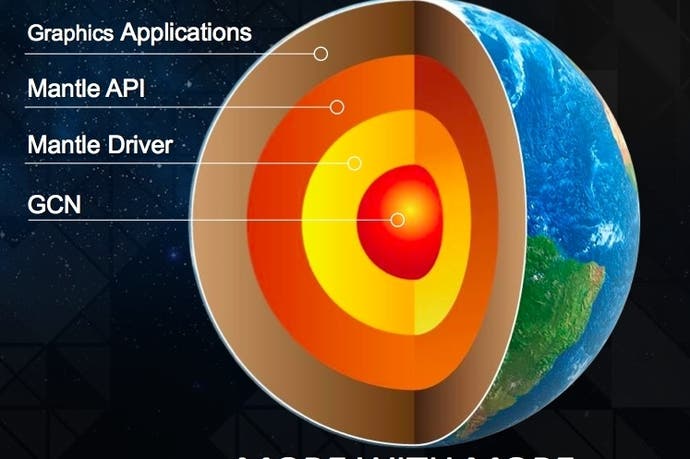Could AMD's Mantle revolutionise PC gaming?
"More performance and a better gaming experience" promised by Battlefield 4 developer.
AMD has revealed Mantle - a new low-level API for PC that offers game developers the opportunity to more directly access graphics hardware, eliminating many of the bottlenecks that hold back PC games performance from reaching its full potential. The new technology was revealed at AMD's GPU14 conference in Hawaii, and is being developed in tandem with EA studio, DICE. Battlefield 4 will be the first Mantle-enabled title, with support enabled via an update scheduled for December.
"Mantle, an AMD initiative to create a new graphics programming model that fully exploits the capabilities of modern GPUs, allows game developers to speak the native language of the AMD Graphics Core Next (GCN) architecture, providing a deeper level of hardware optimisation no other graphics card manufacturer can match," AMD said in a statement. "As part of this initiative, we have worked with leading game developers to create an API specification and associated graphics driver that enables this model on PCs with GCN-based graphics hardware. Mantle was created in direct response to requests from leading game developers, so interest is very high."
In short, AMD has maximised the potential of its graphics technology by allowing developers to access its features directly via a stripped down "to the metal" API. Working in combination with a specialised GPU driver, Mantle completely replaces Microsoft's DirectX 11 layer - a one size fits all rendering solution that historically has under-utilised the raw power of graphics hardware.
Mantle appears to have much in common with the GNM API used in PlayStation 4, offering low-level GPU access while retaining a very high level of compatibility with Microsoft's existing programmable pixel shader language (HLSL). The potential here cannot be under-estimated - much of the optimisation work that is carried out on console versions of multi-platform games can now be rolled out to the PC version too. In addition, there is also the opportunity to exploit AMD-specific hardware features that are under-utilised - or perhaps not even implemented at all - in DirectX.
"Mantle brings console-style 'to the metal' graphics programming to PC graphics for the first time. DICE is promising more performance and better gameplay for Battlefield 4."

However, it's in the performance side of things that we should see potentially radical improvements. Mantle offers developers direct access to graphics RAM for the first time (currently everything is left to the DirectX API), and we are promised a 9x increase in draw calls issued from the CPU. One of the biggest bottlenecks of all, draw calls are very expensive to process, leading many developers to pre-compute elements like environmental detail in order to reduce the number of calls. The vast increase in draw call throughput could have a profound effect on conventional rendering performance, but also offers the potential to more readily bypass pre-computation, resulting in more dynamic, richer, more immersive worlds.
AMD teased Mantle to journalists fleetingly earlier in the week, but held back on specific details. Our initial impression was that while the idea was sound, implementation of all of DirectX's features could be an issue. Yesterday's reveal - presented by DICE's Frostbite engine technical director Johan Andersson - put paid to those concerns. Frostbite itself is one of the more advanced DX11 engines in play today - with Mantle handling the super-advanced Battlefield 4, the API couldn't really get a better stress test. Andersson himself promises "more performance and a better gaming experience" from the Mantle version of Battlefield 4 on PC. The emergence of the new API could also have a profoundly positive effect on Valve's Steambox hardware.
"AMD has an interesting opportunity with Mantle because of their dual console wins, but I doubt Sony and MS will be very helpful," tweeted John Carmack, before adding, "Considering the boost Mantle could give to a Steambox, MS and Sony may wind up being downright hostile to it."
The ramifications could potentially go well beyond upsetting console platform holders. AMD has traditionally championed open source over proprietary code (think OpenCL vs. CUDA) but in the case of Mantle, the firm has been very specific about the fact that Mantle is designed around its own Graphics Core Next (GCN) architecture. In theory, this puts arch-rival Nvidia in a very difficult position. Potentially, we could see key games on AMD graphics cards significantly out-performing the same software running on more expensive Nvidia products. Even if Nvidia produces its own API, we have to wonder if there would be the appetite - or the budget - to support it. By our reckoning, developing Mantle versions won't be cheap, and will probably be limited to big budget games and middlewares like Unreal Engine 4.
Indeed, we could even see DirectX itself under threat. Indie game makers are more likely to target OpenGL as their API of choice as it allows them to port more easily across to Mac, SteamOS, iOS and Android. Competition from Mantle in the triple-A space could make things highly uncomfortable for Microsoft. AMD sources told us today that part of the problem they have faced historically, and which helped drive Mantle development, is that Microsoft is so focused on developing its operating systems, that DirectX development has been sluggish as a consequence.
It's rare that we come across an innovation in the PC space as potentially seismic as Mantle. By partnering with DICE and integrating into Frostbite, AMD is practically guaranteed support across the range of EA's most technologically advanced games - all of which use the engine. Of course, its success will hinge on its level of support. More details - including partner announcements, developer presentations, more in-depth technical discussion, and live demos - are promised for AMD's Developer Summit, taking place on November 11.
This article was based on a press trip to AMD's GPU14 conference in Hawaii. AMD paid for travel and accommodation.

